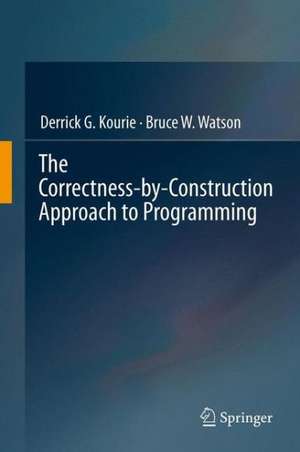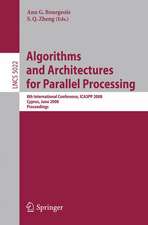The Correctness-by-Construction Approach to Programming
Autor Derrick G. Kourie, Bruce W. Watsonen Limba Engleză Paperback – 9 mai 2014
Kourie and Watson advocate an approach known as “correctness-by-construction,” a technique to derive algorithms that relies on formal theory, but that requires such theory to be deployed in a very systematic and pragmatic way. First they provide the key theoretical background (like first-order predicate logic or refinement laws) that is needed to understand and apply the method. They then detail a series of graded examples ranging from binary search to lattice cover graph construction and finite automata minimization in order to show how it can be applied to increasingly complex algorithmic problems.
The principal purpose of this book is to change the way software developers approach their task at programming-in-the-small level, with a view to improving code quality. Thus it coheres with both the IEEE’s Guide to the Software Engineering Body of Knowledge (SWEBOK) recommendations, which identifies themes covered in this book as part of the software engineer’s arsenal of tools and methods, and with the goals of the Software Engineering Method and Theory (SEMAT) initiative, which aims to “refound software engineering based on a solid theory.”
| Toate formatele și edițiile | Preț | Express |
|---|---|---|
| Paperback (1) | 644.66 lei 6-8 săpt. | |
| Springer Berlin, Heidelberg – 9 mai 2014 | 644.66 lei 6-8 săpt. | |
| Hardback (1) | 650.92 lei 6-8 săpt. | |
| Springer Berlin, Heidelberg – 12 apr 2012 | 650.92 lei 6-8 săpt. |
Preț: 644.66 lei
Preț vechi: 805.82 lei
-20% Nou
Puncte Express: 967
Preț estimativ în valută:
123.37€ • 128.33$ • 101.85£
123.37€ • 128.33$ • 101.85£
Carte tipărită la comandă
Livrare economică 15-29 aprilie
Preluare comenzi: 021 569.72.76
Specificații
ISBN-13: 9783642448546
ISBN-10: 3642448542
Pagini: 280
Ilustrații: XIV, 266 p.
Dimensiuni: 155 x 235 x 15 mm
Greutate: 0.4 kg
Ediția:2012
Editura: Springer Berlin, Heidelberg
Colecția Springer
Locul publicării:Berlin, Heidelberg, Germany
ISBN-10: 3642448542
Pagini: 280
Ilustrații: XIV, 266 p.
Dimensiuni: 155 x 235 x 15 mm
Greutate: 0.4 kg
Ediția:2012
Editura: Springer Berlin, Heidelberg
Colecția Springer
Locul publicării:Berlin, Heidelberg, Germany
Public țintă
ResearchCuprins
Introduction.- Background.- Simple Examples.- Intermediary Examples.- Procedures and Recursion.- Case Study: Lattice Cover Graph Construction.- Case Study 2: Classifying MADFA Construction Algorithms.
Notă biografică
Derrick G. Kourie is a full professor in the Department of Computer Science at the University of Pretoria in South Africa. He has published extensively on software engineering, algorithm construction and analysis, and formal methods and specification languages. His goal is to combine theory and practice in a way that impacts the efficiency and effectiveness of the software process.
Bruce W. Watson is a full professor in the Department of Information Science at Stellenbosch University, and professor extraordinary at the University of Pretoria and director of the FASTAR (Finite Automata Systems – Theoretical and Applied Research) group, spanning the Netherlands, South Africa, the USA, and Finland. His research and development activities cover programming languages, automata and their applications, algorithms, parallelism, and reconfigurable computing.
Bruce W. Watson is a full professor in the Department of Information Science at Stellenbosch University, and professor extraordinary at the University of Pretoria and director of the FASTAR (Finite Automata Systems – Theoretical and Applied Research) group, spanning the Netherlands, South Africa, the USA, and Finland. His research and development activities cover programming languages, automata and their applications, algorithms, parallelism, and reconfigurable computing.
Textul de pe ultima copertă
The focus of this book is on bridging the gap between two extreme methods for developing software. On the one hand, there are texts and approaches that are so formal that they scare off all but the most dedicated theoretical computer scientists. On the other, there are some who believe that any measure of formality is a waste of time, resulting in software that is developed by following gut feelings and intuitions.
Kourie and Watson advocate an approach known as “correctness-by-construction,” a technique to derive algorithms that relies on formal theory, but that requires such theory to be deployed in a very systematic and pragmatic way. First they provide the key theoretical background (like first-order predicate logic or refinement laws) that is needed to understand and apply the method. They then detail a series of graded examples ranging from binary search to lattice cover graph construction and finite automata minimization in order to show how it can be applied to increasingly complex algorithmic problems.
The principal purpose of this book is to change the way software developers approach their task at programming-in-the-small level, with a view to improving code quality. Thus it coheres with both the IEEE’s Guide to the Software Engineering Body of Knowledge (SWEBOK) recommendations, which identifies themes covered in this book as part of the software engineer’s arsenal of tools and methods, and with the goals of the Software Engineering Method and Theory (SEMAT) initiative, which aims to “refound software engineering based on a solid theory.”
Kourie and Watson advocate an approach known as “correctness-by-construction,” a technique to derive algorithms that relies on formal theory, but that requires such theory to be deployed in a very systematic and pragmatic way. First they provide the key theoretical background (like first-order predicate logic or refinement laws) that is needed to understand and apply the method. They then detail a series of graded examples ranging from binary search to lattice cover graph construction and finite automata minimization in order to show how it can be applied to increasingly complex algorithmic problems.
The principal purpose of this book is to change the way software developers approach their task at programming-in-the-small level, with a view to improving code quality. Thus it coheres with both the IEEE’s Guide to the Software Engineering Body of Knowledge (SWEBOK) recommendations, which identifies themes covered in this book as part of the software engineer’s arsenal of tools and methods, and with the goals of the Software Engineering Method and Theory (SEMAT) initiative, which aims to “refound software engineering based on a solid theory.”
Caracteristici
Step-by-step explanation of how to derive mathematically correct algorithms using small and tractable refinements Detailed illustration of the presented methodology through a set of carefully selected graded examples Practical applicability demonstrated by deriving non-trivial algorithms (e.g. in computational geometry) and algorithm taxonomies (as a basis for toolkit construction) Includes supplementary material: sn.pub/extras













